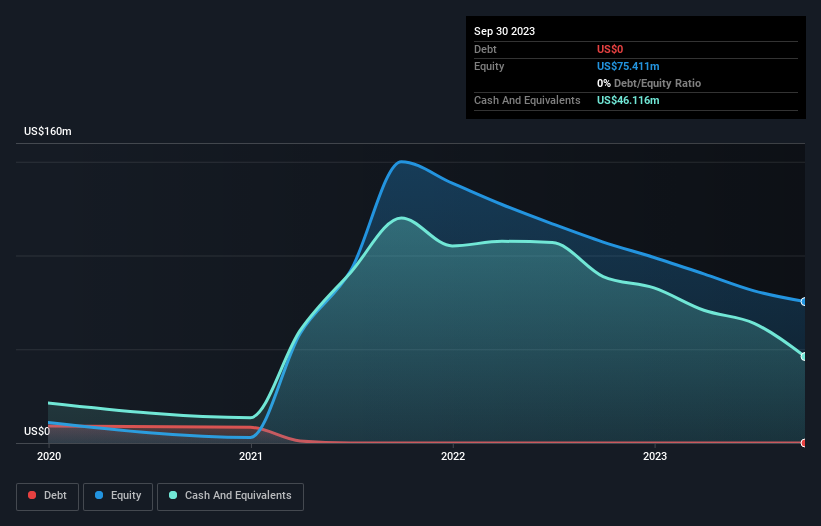Companies Like Sera Prognostics (NASDAQ:SERA) Are In A Position To Invest In Growth
Just because a business does not make any money, does not mean that the stock will go down. By way of example, Sera Prognostics (NASDAQ:SERA) has seen its share price rise 116% over the last year, delighting many shareholders. But while history lauds those rare successes, those that fail are often forgotten; who remembers Pets.com?
So notwithstanding the buoyant share price, we think it's well worth asking whether Sera Prognostics' cash burn is too risky. For the purposes of this article, cash burn is the annual rate at which an unprofitable company spends cash to fund its growth; its negative free cash flow. The first step is to compare its cash burn with its cash reserves, to give us its 'cash runway'.
See our latest analysis for Sera Prognostics
How Long Is Sera Prognostics' Cash Runway?
A company's cash runway is calculated by dividing its cash hoard by its cash burn. When Sera Prognostics last reported its September 2023 balance sheet in November 2023, it had zero debt and cash worth US$46m. In the last year, its cash burn was US$28m. Therefore, from September 2023 it had roughly 20 months of cash runway. While that cash runway isn't too concerning, sensible holders would be peering into the distance, and considering what happens if the company runs out of cash. You can see how its cash balance has changed over time in the image below.
How Is Sera Prognostics' Cash Burn Changing Over Time?
Whilst it's great to see that Sera Prognostics has already begun generating revenue from operations, last year it only produced US$330k, so we don't think it is generating significant revenue, at this point. As a result, we think it's a bit early to focus on the revenue growth, so we'll limit ourselves to looking at how the cash burn is changing over time. While it hardly paints a picture of imminent growth, the fact that it has reduced its cash burn by 26% over the last year suggests some degree of prudence. Clearly, however, the crucial factor is whether the company will grow its business going forward. For that reason, it makes a lot of sense to take a look at our analyst forecasts for the company.
Can Sera Prognostics Raise More Cash Easily?
While Sera Prognostics is showing a solid reduction in its cash burn, it's still worth considering how easily it could raise more cash, even just to fuel faster growth. Companies can raise capital through either debt or equity. One of the main advantages held by publicly listed companies is that they can sell shares to investors to raise cash and fund growth. We can compare a company's cash burn to its market capitalisation to get a sense for how many new shares a company would have to issue to fund one year's operations.
Sera Prognostics' cash burn of US$28m is about 10.0% of its US$281m market capitalisation. Given that is a rather small percentage, it would probably be really easy for the company to fund another year's growth by issuing some new shares to investors, or even by taking out a loan.
How Risky Is Sera Prognostics' Cash Burn Situation?
The good news is that in our view Sera Prognostics' cash burn situation gives shareholders real reason for optimism. One the one hand we have its solid cash runway, while on the other it can also boast very strong cash burn relative to its market cap. While we're the kind of investors who are always a bit concerned about the risks involved with cash burning companies, the metrics we have discussed in this article leave us relatively comfortable about Sera Prognostics' situation. Separately, we looked at different risks affecting the company and spotted 4 warning signs for Sera Prognostics (of which 1 can't be ignored!) you should know about.
If you would prefer to check out another company with better fundamentals, then do not miss this free list of interesting companies, that have HIGH return on equity and low debt or this list of stocks which are all forecast to grow.
Have feedback on this article? Concerned about the content? Get in touch with us directly. Alternatively, email editorial-team (at) simplywallst.com.
This article by Simply Wall St is general in nature. We provide commentary based on historical data and analyst forecasts only using an unbiased methodology and our articles are not intended to be financial advice. It does not constitute a recommendation to buy or sell any stock, and does not take account of your objectives, or your financial situation. We aim to bring you long-term focused analysis driven by fundamental data. Note that our analysis may not factor in the latest price-sensitive company announcements or qualitative material. Simply Wall St has no position in any stocks mentioned.

